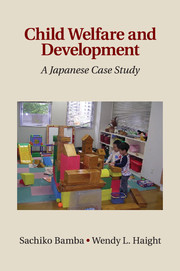Book contents
- Frontmatter
- Contents
- Tables and Figures
- Acknowledgments
- 1 Child-rearing at a Residential Child Care Institution
- 2 Japanese Contexts and Concepts
- 3 The Research Program
- 4 A Developmental Goal for Maltreated Children
- 5 Challenges to Maltreated Children’s Ibasho Creation
- 6 Socialization Practices Underlying Ibasho Creation
- 7 Children’s Lives and Experiences of Ibasho and Mimamori
- 8 Mr. Watanabe’s Responses to the Intervention
- 9 Reflections on Some Challenges of Field Research
- 10 The Emerging Child Welfare Context of Jidou Yougo Shisetsu
- 11 Conclusion: Some Lessons for Culturally Sensitive Child Welfare
- References
- Index
2 - Japanese Contexts and Concepts
Jidou Yougo Shisetsu, Ibasho, and Mimamori
Published online by Cambridge University Press: 07 October 2011
- Frontmatter
- Contents
- Tables and Figures
- Acknowledgments
- 1 Child-rearing at a Residential Child Care Institution
- 2 Japanese Contexts and Concepts
- 3 The Research Program
- 4 A Developmental Goal for Maltreated Children
- 5 Challenges to Maltreated Children’s Ibasho Creation
- 6 Socialization Practices Underlying Ibasho Creation
- 7 Children’s Lives and Experiences of Ibasho and Mimamori
- 8 Mr. Watanabe’s Responses to the Intervention
- 9 Reflections on Some Challenges of Field Research
- 10 The Emerging Child Welfare Context of Jidou Yougo Shisetsu
- 11 Conclusion: Some Lessons for Culturally Sensitive Child Welfare
- References
- Index
Summary
As I was getting ready for work this morning, I happened to overhear a TV program focusing on a residential treatment facility for adolescents with problems such as juvenile delinquency (Tagawa Fureai Gijuku). The boy who was the focus of the program was having difficulty adjusting to the life there. He participated in few activities and rarely interacted with his peers. Adults patiently interacted with him, while providing him with various opportunities to participate in activities and assume roles in the group. Slowly, he began to adjust. I was not watching the TV program carefully on this busy morning, but at the very end my attention was drawn when a representative of the facility used the specific terms, “Ibasho” and “mimamori.” He emphasized that children need their Ibasho, a place in which they feel that adults care about them. For children to achieve their Ibasho, adults’ consistent mimamori is critical. Adults must not give up on them. I thought, “Wow, this view perfectly matches that of adults at the Children’s Academy!”
- Type
- Chapter
- Information
- Child Welfare and DevelopmentA Japanese Case Study, pp. 16 - 40Publisher: Cambridge University PressPrint publication year: 2011



